PU vs Epoxy in Indonesia: how to choose?
If you’ve spent any time around a surf shop or chatted with other surfers in the lineup, you’ve probably heard people talk about PU vs Epoxy boards. For someone trying to buy or upgrade their surfboard, the choice can feel a little confusing — especially if you’re new to surfing in Indonesia, where conditions can be very different from back home.
So, which type of board is right for you?
The truth is, it depends on your experience level, your style of surfing, and the kinds of waves you’ll be riding. Beginners often lean toward epoxy boards because they’re lighter, more durable, and float better. More experienced surfers usually prefer PU boards for their traditional feel and reliable performance across a range of waves. And then there are hybrid “Epoxy” boards, which mix features of both and are becoming increasingly popular with surfers who want a balance of performance and durability.
In this guide, we’ll break down the differences between PU, Epoxy, and Epoxy surfboards, and explain how each one holds up in Indonesian surf conditions. By the end, you’ll have a clearer idea of which board will suit your surfing and the waves you’ll be chasing.
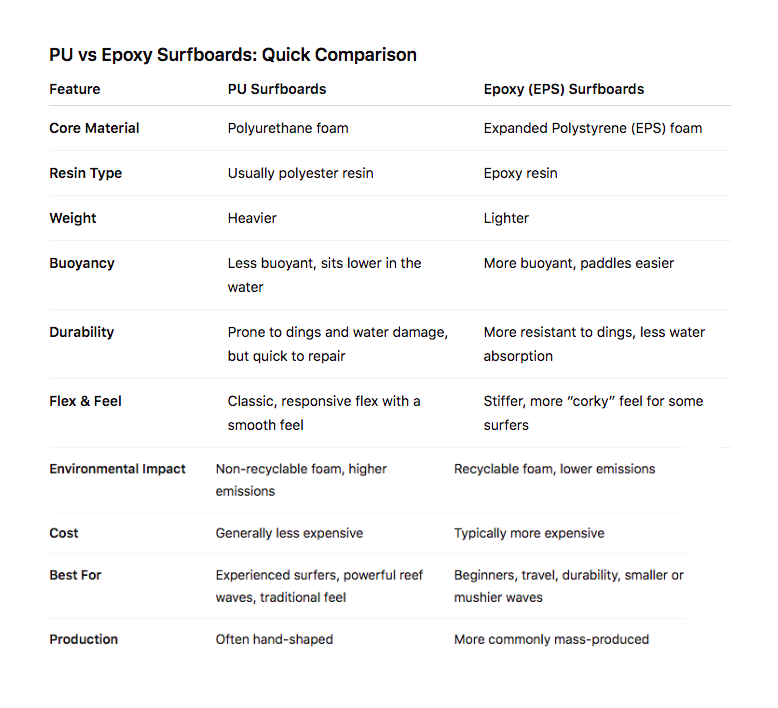
PU vs Epoxy Surfboards: What’s the Difference?
If you’re wondering what sets PU surfboards apart from Epoxy (EPS) boards, you’re not alone. A lot of surfers don’t realize that different boards are built with different materials, and those materials can make a big difference in how a board feels and performs in the water.
In this guide, we’ll walk through:
- How PU boards are made, and their pros and cons
- How EPS/Epoxy boards are made, and their pros and cons
- The role of resin in surfboard construction (Polyester vs. Epoxy)
- Where Epoly boards fit into the picture
- A clear summary comparing PU and Epoxy at a glance
Whether you’re choosing your first board, upgrading your quiver, or just curious about what’s under your feet, this breakdown will help you understand how these boards stack up — especially in the surf conditions you’ll find here in Indonesia.
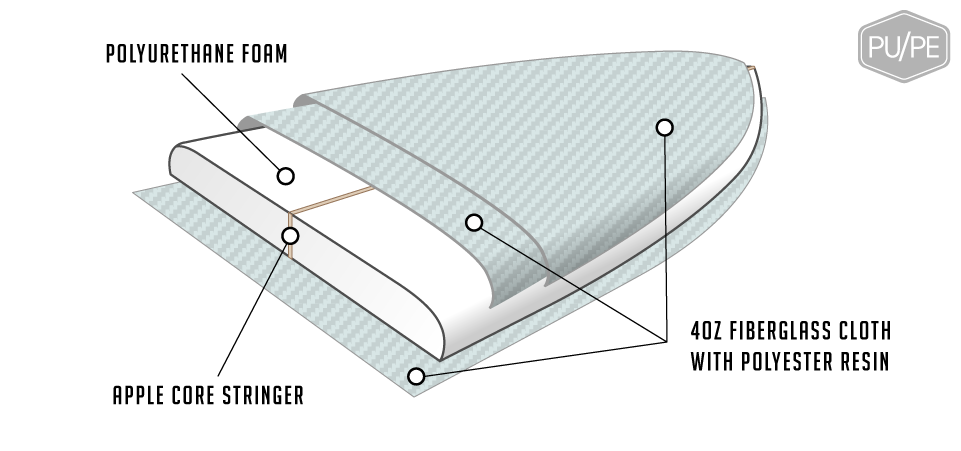
PU Surfboards (Polyurethane Surfboards)
PU surfboards have been around since the 1950s and remain a favorite among experienced and professional surfers. Built with a polyurethane foam core and usually laminated with polyester resin, they offer the classic feel most surfers grew up on — responsive, versatile, and suited to a wide range of conditions.
While PU boards can also be glassed with epoxy resin, the traditional polyester finish is still the standard. This combo creates a board that’s waterproof, durable, and highly responsive in the water, which explains why so many surfers still prefer them today.
How PU Boards Are Made
Making a PU board is a hands-on process that relies heavily on craftsmanship. It all starts with a polyurethane blank — a block of foam that roughly resembles a surfboard. From there, the shaper brings the board to life through several steps:
- Adding the Stringer – A thin strip of wood is glued down the center of the foam. This acts as the board’s spine, controlling its strength and flex.
- Shaping the Blank – Using saws, planers, and sanding tools, the shaper carves out the rocker, rails, and overall outline, as well as spaces for fin boxes and leash plugs.
- Artwork & Logos – If the board is getting custom graphics, these are added directly onto the foam before fiberglassing.
- Glassing – Fiberglass cloth is laid over the shaped blank and sealed with polyester resin, creating a hard, protective outer shell. The number of layers affects both the board’s strength and its weight.
- Installing Features – Fin boxes, leash plugs, and any other hardware are set in place and reinforced with resin.
- Sanding & Finishing – The final sanding smooths out the surface, which not only looks good but also influences how the board moves through the water.
The result: a classic PU surfboard ready to hit the lineup.
Pros of PU Boards
✔️ Responsive flex and feel – Delivers that smooth, “classic” ride surfers love.
✔️ Extra weight adds drive – Helps maintain momentum in smaller or choppier surf.
✔️ High maneuverability – Great for tight turns, critical maneuvers, and faster reactions.
✔️ Easier repairs – Polyester resin cures faster than epoxy, making ding fixes quicker.
Cons of PU Boards
❌ Less durable – More prone to dings, dents, and even snapping compared to EPS boards.
❌ Water damage risk – If a ding isn’t repaired quickly, water can seep in and ruin the board.
❌ Environmental impact – PU foam and polyester resin are toxic to produce and not recyclable.
❌ Flex wears out – Over time, the board loses that crisp responsiveness.
❌ Fixed buoyancy – PU foam density doesn’t change, limiting options for added flotation.
👉 In Indonesia, PU boards shine in clean reef waves where responsiveness and control really matter. But for traveling surfers or anyone hitting shallow breaks with a higher risk of dings, the lower durability can be a downside
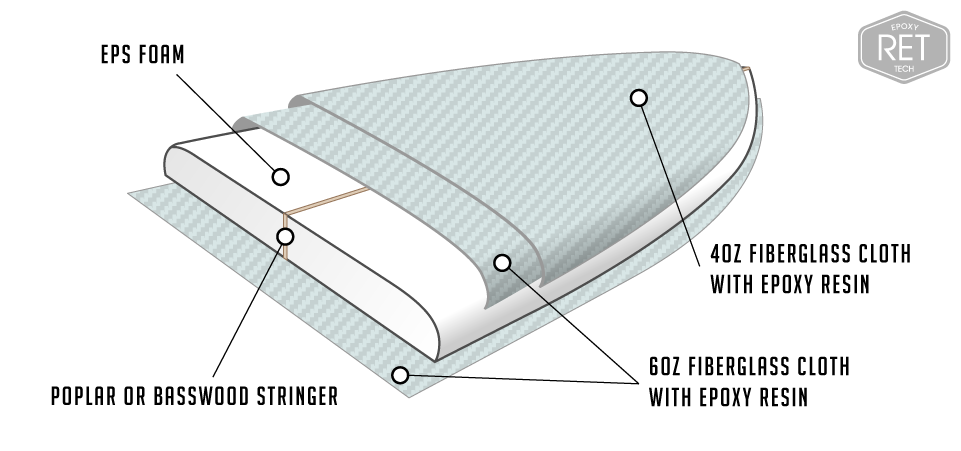
EPS / Epoxy Surfboards
Compared to the long history of PU boards, EPS surfboards are relatively new on the scene, only becoming mainstream in the late 1990s and early 2000s.
The big difference lies in the foam core:
- PU boards use polyurethane.
- EPS boards use expanded polystyrene (EPS) — a foam made of tiny fused beads.
EPS boards are almost always laminated with epoxy resin (instead of polyester resin), which is why they’re often simply called epoxy boards. The resin makes them stronger, lighter, and more flexible than traditional PU/polyester builds.
This durability is why epoxy boards are often recommended for beginners and are the go-to choice for surf schools and rentals. They handle the knocks and bumps of daily use far better than PU boards — so while your instructor’s claim that an EPS board could survive being tossed off a cliff might be a stretch, it’s not far off the mark in terms of toughness.
In the water, EPS boards feel lighter and more buoyant, which can be a blessing when paddling or catching waves. The weight difference is most noticeable in longboards, where the extra float makes a significant impact.
How EPS Boards Are Made
The shaping process is similar to PU boards, but with a few key differences:
- Stringer (Optional) – Some EPS boards include a wooden stringer for added strength or flex control, but many don’t need one thanks to the strength of epoxy resin.
- Shaping the Blank – The shaper starts with an EPS foam blank, lighter than PU, and carves the rails, rocker, and outline, cutting spaces for fins and leash plugs.
- Artwork & Sealing – If artwork is added, the blank is usually sealed first to create a smoother surface for painting.
- Glassing – Layers of fiberglass are applied, then sealed with epoxy resin. Epoxy takes longer to cure than polyester, so the process requires a controlled environment for best results.
- Installing Hardware – Fin boxes and leash plugs are set and reinforced with epoxy.
- Sanding & Finishing – The board is sanded smooth, just like a PU board, before it’s ready to ride.
Pros of EPS Boards
✔️ Lightweight – Easier to carry, paddle, and maneuver.
✔️ Extra buoyancy – Makes catching waves smoother; often lets you ride a shorter board than your PU equivalent.
✔️ Durable – Great for travel and everyday use, especially when boards take a beating.
✔️ Eco-friendly edge – EPS foam can be recycled, and production is generally less toxic than PU.
Cons of EPS Boards
❌ Corky feel – Some surfers find the lightness less grounded compared to PU.
❌ Stiffer flex – Can feel less “lively” than PU boards, especially in critical turns.
❌ Adjustment period – Switching from PU to EPS can take time, as the ride feels different underfoot
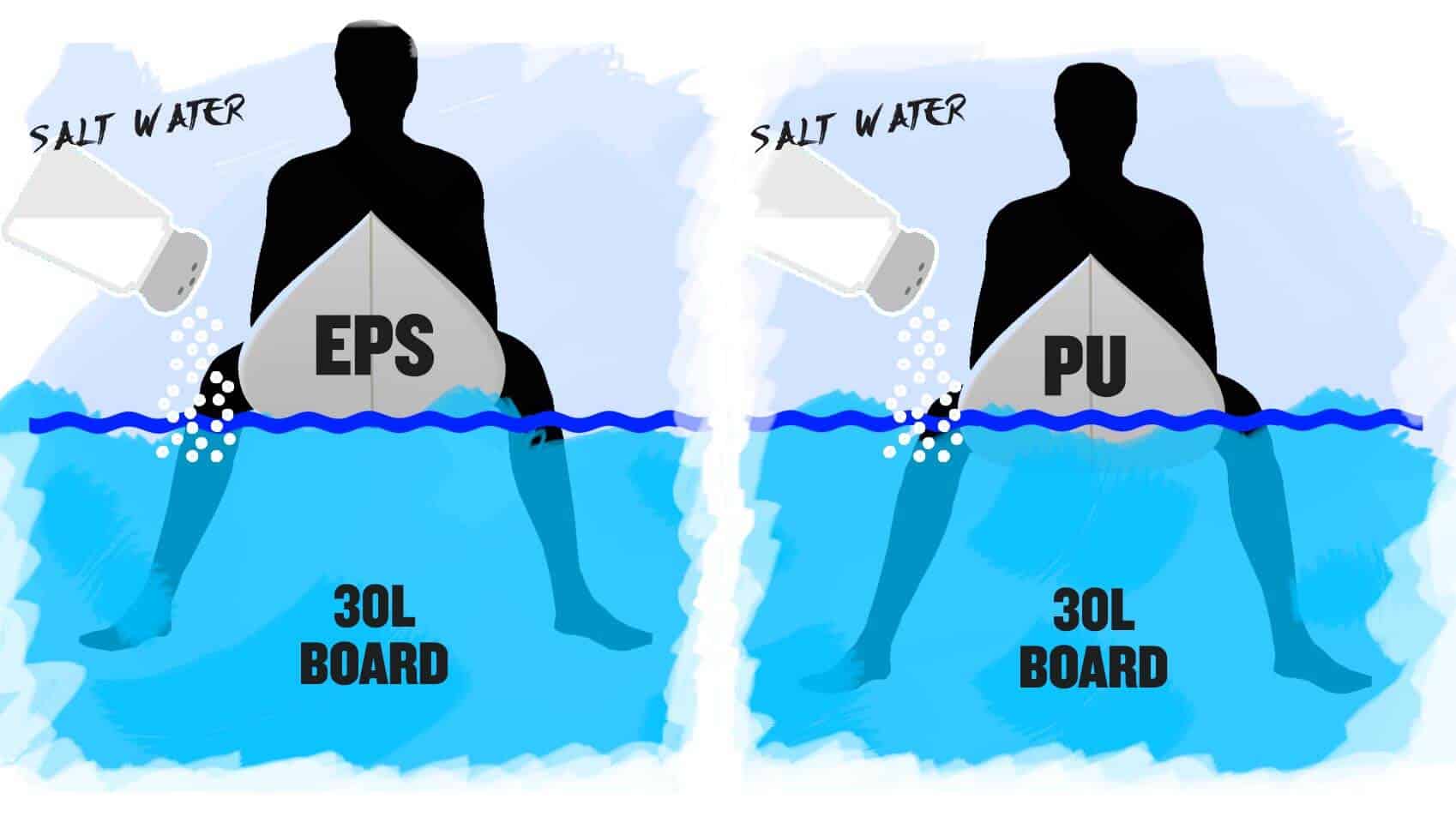
Polyester Resin vs. Epoxy Resin
As we’ve seen, the foam core isn’t the only thing that separates PU and EPS boards — the resin matters too.
- Polyester resin is the traditional choice used on most PU boards. It cures quickly, is easy for shapers to work with, and has been the standard in surfboard building for decades. But it comes with downsides: it’s more fragile, more prone to cracking, and its production releases higher levels of toxic compounds.
- Epoxy resin, used almost exclusively on EPS boards, is stronger, more flexible, and provides better water resistance. Boards glassed with epoxy tend to last longer and are less likely to take on water after a ding. Epoxy resin is also less toxic to produce, though it’s more expensive and requires more time to cure.
Common FAQs
Can I use polyester resin to repair an epoxy board?
No — polyester resin will eventually eat through EPS foam and damage the board.
Can I use epoxy resin to repair a PU board?
Yes, you can. PU boards can be repaired with either polyester or epoxy resin, though polyester is generally the better match.
👉 Pro tip: If you’re heading on a surf trip in Indonesia, pack a small ding repair kit with the right resin for your board. With coral reefs, airport baggage handlers, and bumpy scooter rides, it can save your session.
PU vs Epoxy: Final Thoughts
At the end of the day, both PU and Epoxy boards have their strengths:
- PU delivers the classic flex and feel that experienced surfers love.
- Epoxy offers durability and buoyancy, making it great for beginners, travelers, or anyone who wants a tougher board.
But remember — the material alone doesn’t define the board. Shape, rocker, volume, glassing, and even custom tweaks from your shaper all play a huge role in how your board performs.
If you’re surfing in Indonesia, think about the waves you’ll spend the most time on:
- Reef breaks and performance surfing? PU might give you that sharp, connected feel.
- Travel, long sessions, and durability? Epoxy could be the smarter pick.
Whichever way you lean, the best choice is the board that gets you out in the water more often, feeling confident, and stoked to surf

👉 Still not sure which to choose? Here’s a simple way to think about it:
- If you’re traveling through Indonesia or just starting out, epoxy’s durability and buoyancy will make your sessions easier and your board last longer.
- If you’re chasing performance on heavier reef waves, PU will give you that classic, responsive feel underfoot.
And of course, the best option isn’t always “one or the other.” With custom boards, you can fine-tune materials, shape, and glassing to get the perfect fit for your style and the waves you’ll be surfing.
👉 Check out our custom surfboard options here



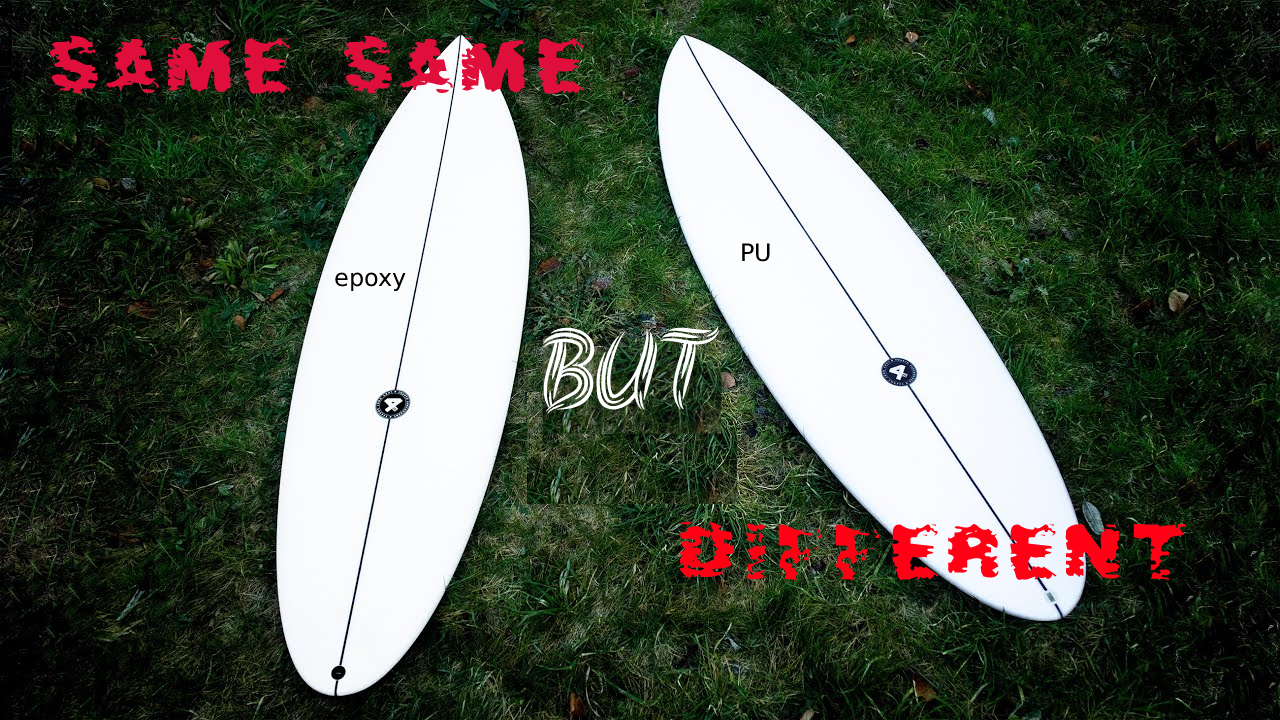









.png)


.avif)
